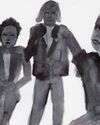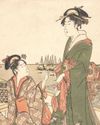Forty years ago, Rei Kawakubo began creating subversive, gender-bending clothes for menwhen no one else was. She still is.

EARLY ONE MORNING, in the beginning of April, just as the cherry blossoms came into full bloom in Tokyo, 100-odd people gathered at the entrance to an anonymous office building in Aoyama, an elegant and sedate neighbourhood known for its designer stores and expensive French restaurants. Unlike the building’s facade (squat, brick, unremarkable) or its interior (empty, beige, somehow even more unremarkable), the people making their way inside were, like the pink petals feathering the city’s sidewalks, impossible to ignore. Some looked like religious fundamentalists or figures from 16th-century portraits, others like extras from “La Strada”. They nodded and held doors open for one another, but remained quiet and unsmiling.
Four times a year, Comme des Garçons, the avant-garde Japanese fashion label founded by Rei Kawakubo in 1969, puts on runway shows exclusively for its own employees — the receptionists and store managers and H.R. associates — people with no business flying to Paris for fashion week but who, according to the rigorous standards set by their employer, must be intimately familiar with all aspects of the aesthetic order to which they have dedicated their lives. Elevated plywood catwalks, edged with neat rows of plastic folding chairs, were erected in grey-carpeted conference rooms; the fluorescent lights flickered. There, models in full hair and makeup paraded the season’s designs thousands of miles away from and many months past the French fashion schedule.
この記事は T Singapore: The New York Times Style Magazine の October 2018 版に掲載されています。
7 日間の Magzter GOLD 無料トライアルを開始して、何千もの厳選されたプレミアム ストーリー、9,000 以上の雑誌や新聞にアクセスしてください。
すでに購読者です ? サインイン
この記事は T Singapore: The New York Times Style Magazine の October 2018 版に掲載されています。
7 日間の Magzter GOLD 無料トライアルを開始して、何千もの厳選されたプレミアム ストーリー、9,000 以上の雑誌や新聞にアクセスしてください。
すでに購読者です? サインイン

Look At Us
As public memorials face a public reckoning, there’s still too little thought paid to how women are represented — as bodies and as selves.

Two New Jewellery Collections Find Their Inspiration In The Human Anatomy
Two new jewellery collections find their inspiration in the human anatomy.

She For She
We speak to three women in Singapore who are trying to improve the lives of women — and all other gender identities — through their work.
Over The Rainbow
How the bright colours and lively prints created by illustrator Donald Robertson brought the latest Weekend Max Mara Flutterflies capsule collection to life.

What Is Love?
The artist Hank Willis Thomas discusses his partnership with the Japanese fashion label Sacai and the idea of fashion in the context of the art world.

The Luxury Hotel For New Mums
Singapore’s first luxury confinement facility, Kai Suites, aims to provide much more than plush beds and 24-hour infant care: It wants to help mothers with their mental and emotional wellbeing as well.

Who Gets To Eat?
As recent food movements have focused on buying local or organic, a deeper and different conversation is happening among America’s food activists: one that demands not just better meals for everyone but a dismantling of the structures that have failed to nourish us all along.

Reimagining The Future Of Fashion
What do women want from their clothes and accessories, and does luxury still have a place in this post-pandemic era? The iconic designer Alber Elbaz thinks he has the answers with his new label, AZ Factory.

A Holiday At Home
Once seen as the less exciting alternative to an exotic destination holiday, the staycation takes on new importance.
All Dressed Up, Nowhere To Go
Chinese supermodel He Sui talks about the unseen pressures of being an international star, being a trailblazer for East Asian models in the fashion world, and why, at the end of the day, she is content with being known as just a regular girl from Wenzhou.